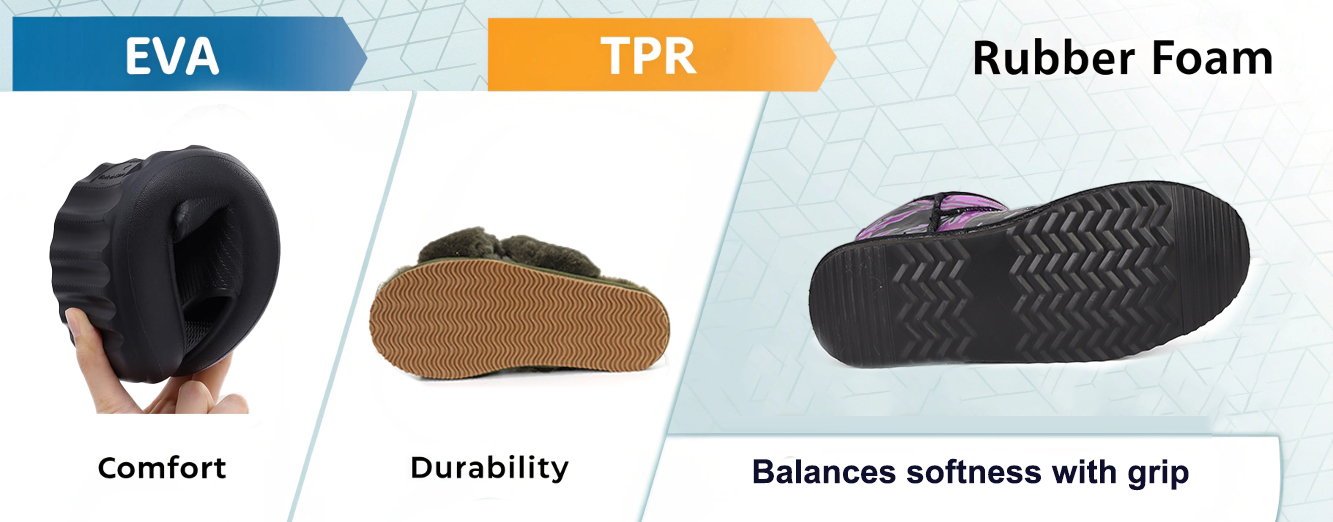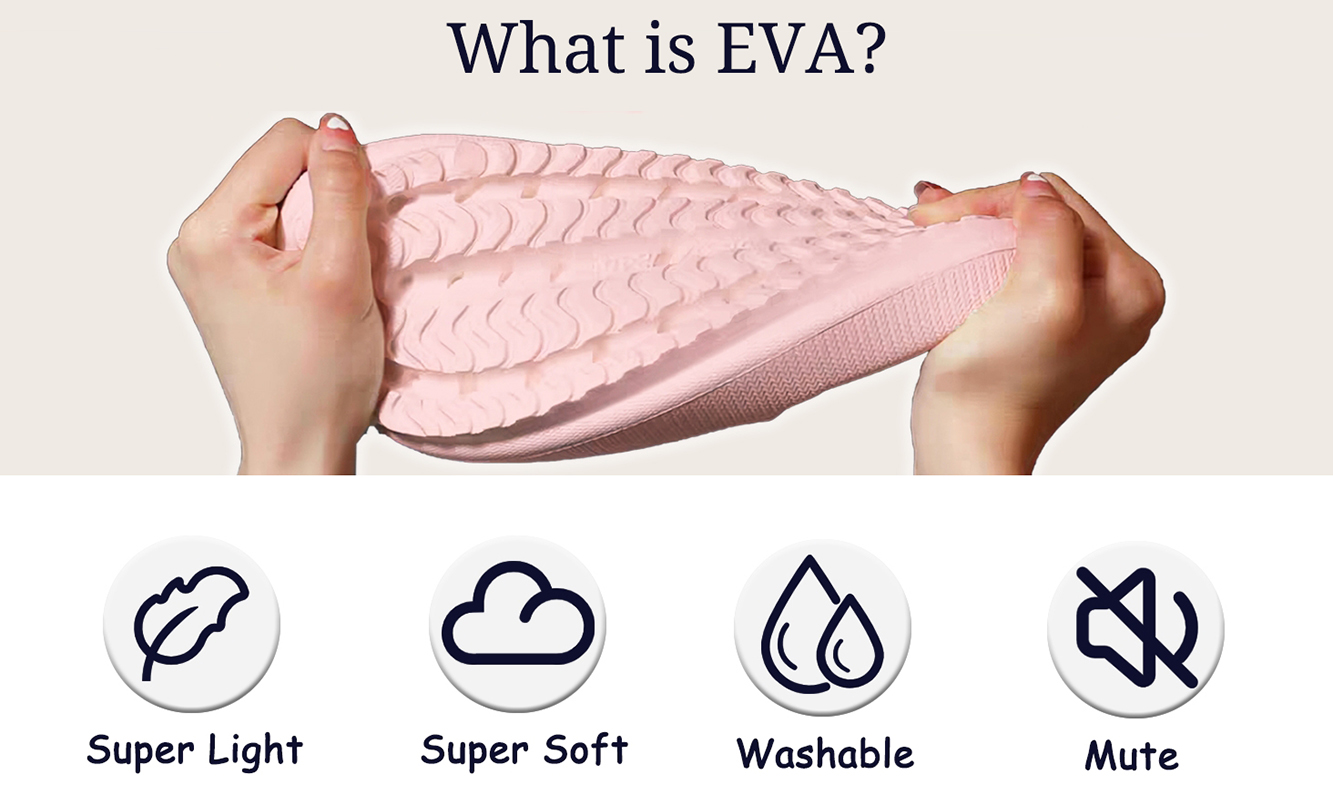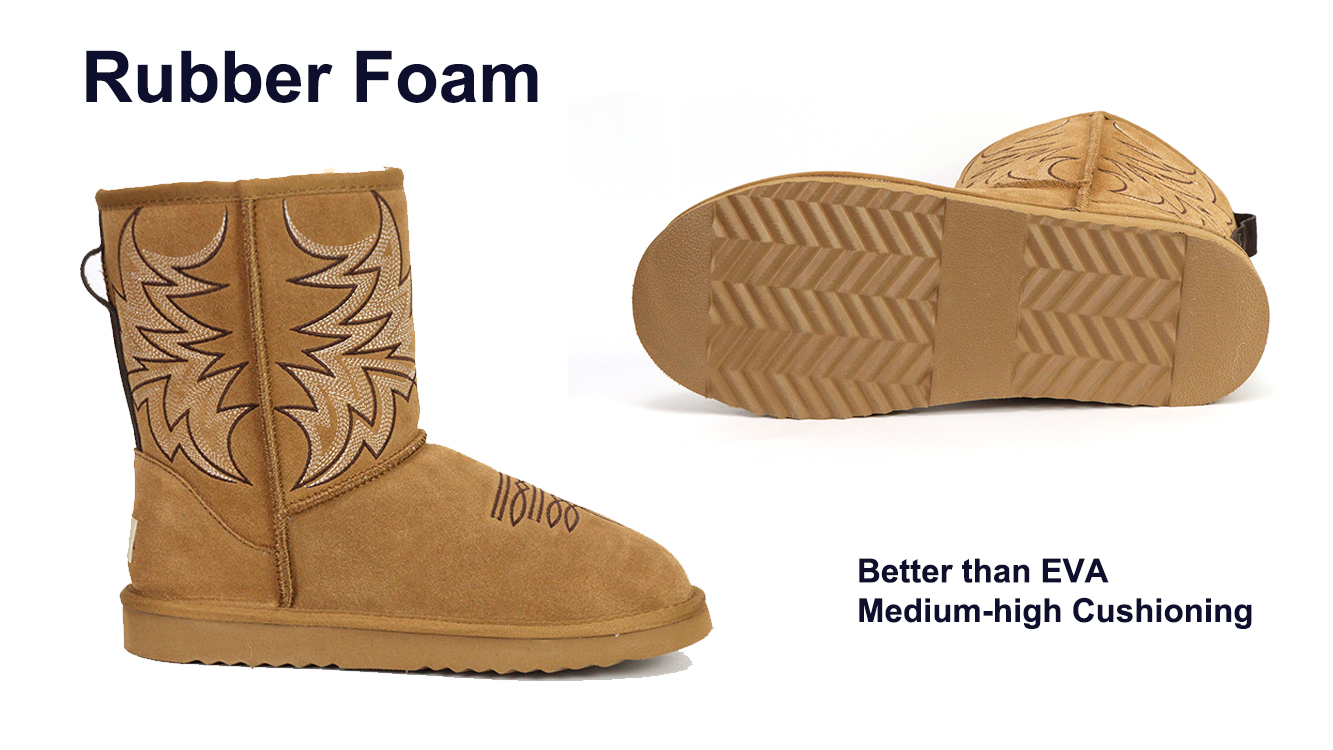
Finding the right shoe sole material can be confusing—especially when you're choosing between EVA1, TPR2, or rubber foam3. Each type has its pros and cons.
EVA1 is lightweight and cushy, TPR2 is durable and slip-resistant, and rubber foam3 balances softness with grip. Choosing the right one depends on your product needs and customer preferences.
When I started working with different factories for our slipper lines, I realized that the sole material wasn’t just about price—it was about comfort, durability, and even branding.
[Table of Contents]
What is EVA and When Should I Use It?

EVA1 is a popular choice for soft and flexible footwear. But is it the right one for your brand?
EVA1 is best for lightweight, cushioned slippers or sandals. It’s flexible, waterproof, and easy to mold, making it ideal for casual indoor or beachwear.
Key Features of EVA
| Feature | Description |
|---|---|
| Weight | Very lightweight |
| Comfort | High cushioning and softness |
| Waterproof | Yes |
| Cost | Low to medium |
| Use Case | Indoor slippers, pool slides, flip-flops |
EVA1 stands for Ethylene Vinyl Acetate. It's one of the most common sole materials used in our cozy indoor slippers. Customers love it because it feels soft and absorbs shocks well. Plus, it’s great for printing custom patterns.
However, EVA1 wears out faster than rubber4 or TPR2. I recommend using it for seasonal collections or low-impact usage styles.
What Makes TPR a Good Option?

TPR2 has been a go-to for styles that need durability and a solid grip. But when should you use it instead of EVA1?
TPR2 is best for outdoor slippers and daily wear shoes. It's durable, flexible, and offers excellent anti-slip properties on different surfaces.
Key Features of TPR
| Feature | Description |
|---|---|
| Durability | High |
| Grip | Excellent anti-slip performance |
| Flexibility | Good, more elastic than hard rubber4 |
| Cost | Medium |
| Use Case | Outdoor slippers, streetwear-style slippers |
TPR2 stands for Thermoplastic Rubber. It behaves like rubber4 but can be molded like plastic, making it a great mix of both. It’s especially useful for brands that want more structure in their designs.
We often use TPR2 for collaborations with brands targeting streetwear or all-weather usage. It adds weight but also value in performance.
Why Choose Rubber Foam Instead?

Rubber foam3 isn’t as widely talked about as EVA1 or TPR2, but it has some unique benefits.
Rubber foam3 offers a nice mix of softness, flexibility, and grip. It’s best for brands that want a premium feel without compromising slip resistance.
Key Features of Rubber Foam
| Feature | Description |
|---|---|
| Cushioning | Medium-high |
| Grip | Good, especially indoors |
| Durability | Better than EVA1, less than full rubber4 |
| Cost | Medium to high |
| Use Case | High-end indoor slippers, branded collections |
This material feels more “premium” than EVA1 and performs better over time. One of our long-term partners uses rubber foam3 for their eco-luxe collection because it holds prints well and adds a quiet grip, which is perfect for indoor wood floors.
Rubber foam3 is also heavier than EVA1, which gives the product a more “solid” feel—something customers associate with better quality.
How Do I Choose the Right Material for My Slippers?
With so many options, how do you match the sole material to your product vision?
Think about your target user, brand positioning, and typical usage scenarios. Use EVA1 for light and flexible styles, TPR2 for durability, and rubber foam3 for high-end indoor comfort.
Here’s a quick guide to help you decide:
| Goal | Best Material |
|---|---|
| Light and budget-friendly | EVA1 |
| Outdoor and anti-slip | TPR2 |
| Premium indoor comfort | Rubber Foam3 |
Sometimes, the client’s target market helps me decide too. For example, our younger online fashion brand clients usually go with EVA1 to keep costs down and styles fresh. But luxury or traditional buyers prefer something more solid, like rubber foam3.
In the end, it’s not just about the material—it’s about the full user experience.
Conclusion
EVA1 is light, TPR2 is tough, and rubber foam3 is balanced—each serves different footwear needs.
Footnotes
-
EVA (Ethylene Vinyl Acetate) is a lightweight, shock-absorbing material widely used in footwear soles. Learn more about how it's made and used in shoes. ↩ ↩ ↩ ↩ ↩ ↩ ↩ ↩ ↩ ↩ ↩ ↩ ↩ ↩ ↩
-
TPR (Thermoplastic Rubber) is a durable, anti-slip material that combines the benefits of rubber and plastic, often used in outsoles. ↩ ↩ ↩ ↩ ↩ ↩ ↩ ↩ ↩ ↩ ↩
-
Rubber foam is a flexible, cushioning sole material offering a premium feel and moderate durability—great for indoor use. ↩ ↩ ↩ ↩ ↩ ↩ ↩ ↩ ↩ ↩
-
Rubber is a natural or synthetic polymer known for high durability and grip, often used in high-performance shoe soles. ↩ ↩ ↩ ↩

